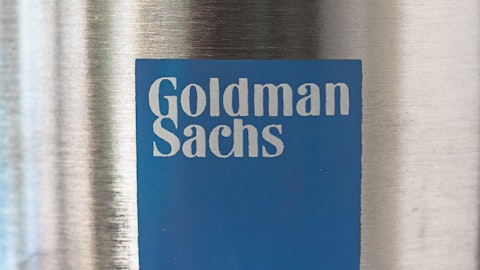Carter Gould: Great. Thanks. Good morning. Congrats on all progress. I wanted to dive into bimagrumab ahead of the Phase 2b data forthcoming. Can you talk for a bit around the importance of showing statsig or clear dose response across the composition of the weight loss drivers and maybe as well as the importance of not blunting the overall weight loss as you contemplate a move to Phase 3 potentially? Thank you.
Dave Ricks: Thanks, Carter, for the question. Dan, you want to comment on the bimagrumab?
Dan Skovronsky: Yes. Thanks, Carter. It’s a good question. Bimagrumab is a very different mechanism of weight loss versus incretins, but one that we think could be important in combination with incretins. So bimagrumab, we think will likely have important effects on adipose tissue as well as muscle mass. And so our hope is to see increased muscle mass and increased ratio, I should say of lean to fat mass by combining bimagrumab with incretins. In this present study, it’s being evaluated both as monotherapy in combination with semaglutide at different doses. So we’ll see if weight loss effects on fat tissue stack, and we’ll see if effects on lean body mass that we’re seeing in previous bimagrumab monotherapy studies work in combination with incretin. Looking forward to seeing that, too.
Joe Fletcher: Thanks Dan. Paul, next question?
Operator: The next question is coming from Kripa Devarakonda from Truist Securities. Kripa your line is live.
Kripa Devarakonda: Hey guys. Thank you much for taking my question and congrats on all the progress. I have a question about your radio pharma pipeline. You mentioned PNT2002 in your oncology pipeline. Can you talk about how you see that advancing? And given what you’ve seen so far, where you see this being placed in the landscape in terms of market share? Thank you.
Dave Ricks: Thanks, Kripa, for the question. Jake, calling you to maybe opine a little bit on our radioligand efforts, PNT2001 in particular?
Jake Van Naarden: Yes, happy to. Thanks for the question. We’re really excited about bringing radiopharmaceuticals into the portfolio by way of the acquisition of Point Biopharma, and we are supplementing that acquisition with additional work through our Discovery Labs and the ability to make these medicines ourselves. So I expect we’ll have more to talk about in terms of additional medicines over the course of the next couple of years in addition to PNT2001. But specific to that question, 2001 is a PSMA-directed therapy for prostate cancer conjugated to actinium, the altimeter. And I think while the actinium holds a lot of promise over lutetium, particularly in the context of creating double-stranded DNA breaks versus single stranded and the ability to perhaps drive more efficacy for patients for prostate cancer.
I think one of the limitations of the existing agents is that they probably cause too much salivary gland toxicity to be real durable products. And so the POINT team designed a novel PSMA-directed ligand with increased tumor uptake relative to the salivary gland in order to drive more therapeutic index using actinium as the payload. So we’re just getting started with the Phase 1 experience right now. So I don’t have a lot to say about what we’re seeing just yet. But the preclinical package looked really interesting and differentiated from the other PSMA ligands that exist out there. So we’re looking forward to putting it through its Phase 1 paces, and we’ll see what we have. Depending on the clinical profile, I think there’s the potential to improve outcomes in patients that have already seen a lutetium based agent, maybe go ahead of that and compete with the lutetium based agents or perhaps even go even earlier in therapy as PSMA expression really exists in the continuum of prostate cancer care.
So more to come on that as we define the clinical profile in the Phase 1.
Dave Ricks: Thanks, Jake. Paul, I think we’ve got time for maybe one more question. We’re right at 11:00. So maybe a final question in the queue.
Operator: Okay. And the final question today is coming from James Shin from Deutsche Bank. James, your line is live.
James Shin: Hey, good morning guys. Thanks for question. I just wanted to try and reconcile the guidance lift with the 1.5 times sellable doses being maintained. Thank you.
Dave Ricks: Okay. James, maybe I’ll give Anat to talk about the guidance and how the guidance raised relates to the 1.5 – those comments.
Anat Ashkenazi: Yes. So let’s start with the 1.5 dose – sellable dose comment that I made on the guidance call in February. So that reference is not a number of devices, but number of sellable doses. And as we ramp up capacity for KwikPen, recall that unlike the single-use vial or the auto-injector, that KwikPen is a multidose device that has multiple dose available for patients. That common [ph] referred to the second half of this year versus the second half of last year. So we’re expecting that total sellable doses this year in the second half will be at least 1.5 times where we were second half of last year. That remains unchanged. But the level of confidence we have in our ability to progress on each node of our capacity that’s coming online or will get approved, et cetera, has just increased.





